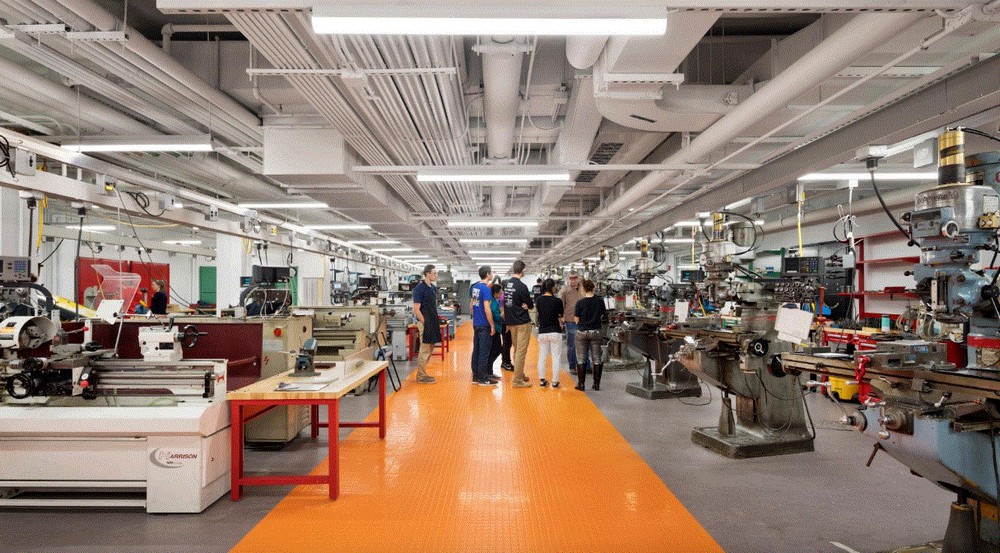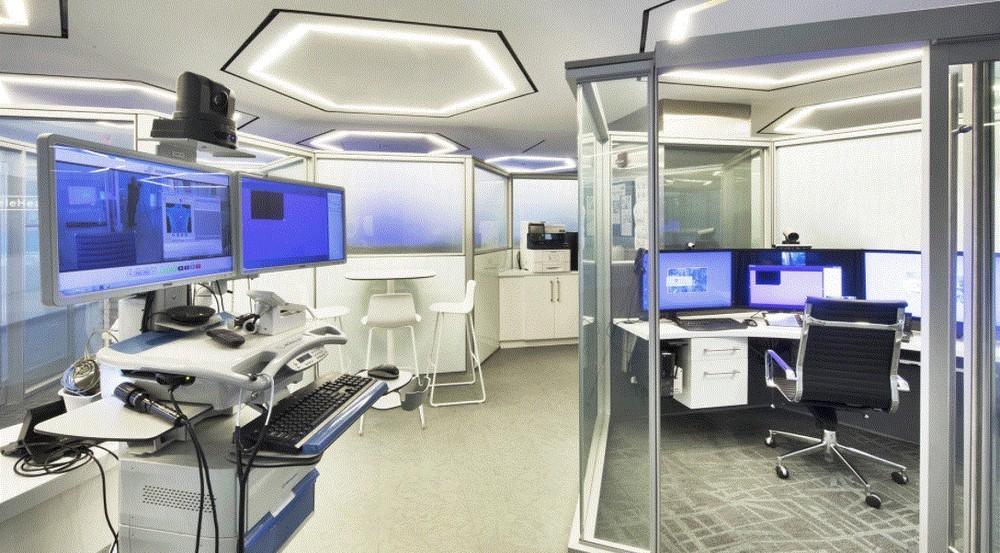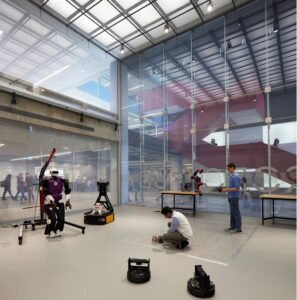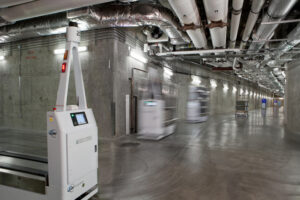 Science and Tech lab at Cornell’s Upson Hall, Ithaca, New York. Departments we have never heard of may come to be in the future – one day we may be designing “nanomacy,” which may combine the functional needs of pharmacies, clinical labs and nanotechnology spaces.
Science and Tech lab at Cornell’s Upson Hall, Ithaca, New York. Departments we have never heard of may come to be in the future – one day we may be designing “nanomacy,” which may combine the functional needs of pharmacies, clinical labs and nanotechnology spaces.  Miami Nicklaus Children’s Hospital in Florida. Command Centers will become absolutely important, as more support and clinical care moves to technologically supported spaces, patients receive telecare and clinicians deliver care virtually.
Miami Nicklaus Children’s Hospital in Florida. Command Centers will become absolutely important, as more support and clinical care moves to technologically supported spaces, patients receive telecare and clinicians deliver care virtually. Subscribe Now
The Hospital of the Future
By Ashley Dias
The edge of innovation and the possibility horizon
Hospitals will always be a place people make pilgrimages to — for healing and care — but the dynamics and degree of the pilgrimage is changing at a more rapid pace than ever before. And, as the world gets more technologically oriented and digitally savvy, it is becoming much easier to imagine the future than remember the past. The nimbleness of the healthcare industry in response to the pandemic has been a major catalyst and will likely accelerate our applying the technology opportunities available. But, what does all this “technology opportunity” mean for hospital planning and design? Below are some imaginations on what could be in the future. I’m not a futurist, but rather a visionist — always trying to reveal the possibilities in my mind’s eye.
Virtual reality
Ideally, virtual reality will improve patients’ comfort, sense of control and social support, helping to reduce stress, entertain and combat loneliness. Patients previously unable to leave their beds can now do so via immersive, multisensory virtual experiences. This may happen very soon, especially given the Metaverse in development by Mark Zuckerberg’s Meta and the announced partnership on Nov. 10 between Meta and Microsoft to allow integration of software products.
Augmented reality
There’s potential for augmented reality to improve access, wayfinding and patient safety by identifying patients upon entry and arrival, supplementing visitor views with improved information of where to go. Patient registrars will be a thing of the past, replaced by greeters whose goal is improving consumer satisfaction through immediate personal attention. Clinicians will be able to identify patients and access data through their AR view instead of scanning wristbands and interfacing with workstations to call up information. Emergency departments could have sub-units for “biorepair” for biologically integrated devices; as our physiology extends to include applied technology, these integrated devices will need maintenance and mending. AR could also improve procedural treatments — informing clinicians of data without looking up from the patient to an archaic monitor across the room, helping them to maintain visual focus on the procedure and not data on ancillary screens.
Artificial intelligence
Artificial intelligence will improve pattern understanding, diagnosis accuracy and speed, treatment planning and clerical functions. It has the opportunity to reduce manual human work both medically and administratively. More time can be spent on the consumer experience and relationship, while reducing officing space and personnel required for clerical operations. We are already seeing key strategic partnerships related to this; in May 2021, HCA Healthcare and Google Cloud announced they are teaming to accelerate this digital transformation. The press release noted the partnership is “to help create a secure and dynamic data analytics platform for HCA Healthcare and enable the development of next-generation operational models focused on actionable insights and improved workflows.” The goal in the partnership is to leverage data from HCA Healthcare’s 32 million patient encounters with Google’s Could Healthcare Data Engine and BigQuery, a serverless, multi-cloud warehouse. This wealth of data and AI analytic ability will combine to develop algorithm-informed clinical decision assistance, as well as improve quality, safety and outcomes by identifying clinical practice improvement opportunities.
But, it’s not just clinical care in the crosshairs of the AI opportunity, it’s also support services optimization analytics —mined insights could improve supply chain management, physical plant or support personnel utilization.
The AI opportunity on the horizon is incredibly exciting and will likely spur even more integrated, interoperative technology via connected softwares and hardwares —such as monitoring devices or health record optimizers. Of course, as AI advances to improve healthcare, so too will the focus on patient privacy and personal data security.
Hospital at-home/virtual beds
We have seen the shift of lower-acuity care out of the hospital for a while now. This will continue as virtual beds become more feasible with technology integration and connectivity. The impact is likely improving the consumer experience by reducing the need to be cared for in the hospital proper. Patients will be connected by the above-mentioned technologies, and mobile care teams will be deployed with required equipment. The potential impact is greatest for patients in observation status or rehabilitation. Complex care will absolutely stay in the hospital for the proximity it requires. This paradigm shift has already started. One example is New York’s Mount Sinai Hospital and its Hospital-At-Home Program, with a predicted 30% of inpatient care to soon be executed at home. And, Intermountain Health is establishing “virtual hospitals” with their Connect Care Pro program bringing specialized care to rural communities. “Clinical command centers” will be required to properly operate this model.
Nanotechnology

University of Waterloo Engineering Building, Ontario, Canada. Spaces we’re accustomed to seeing in higher education environments will become more prevalent in the hospital and academic medical – particularly maker spaces geared to discovery in technology application.
Nanomacies will be a new department and space. What’s a nanomacy? It could be the blended functions of pharmacy, clinical lab, biomedical maker spaces —facilitating the integration of nanotechnology and personalized medicine. Also, the impetus for why we will need “biorepair units” mentioned above.
Supersonic networking and clouded-care
All of the above will require extreme computing and data support. Today we talk of logistics buildings; in the future we will talk also of “data hubs” — onsite data centers with power and capacity beyond what has been seen to date. Communication closets will become data shafts competing with MEP systems for infrastructure space king.
Drones & robotics

Rush University Medical Center in Chicago, Illinois. Support services are evolving to improve supply chain distribution efficiency. Robot-guided vehicles will become the norm.
Support services flow and clinical care transport will be supplemented by drones. Fleets of drones will have to be stored, charged and operated from droneports. Clinical care in the hospital and at home will increasingly be supported by robotics of all scales. We already have clients looking to integrate drones into just-in-time support models.
So, as we think about the hospital of the future, it will always be our community beacon for healing and care. But its borders are digitally extending, and the pilgrimage we make to it possibly getting more convenient, shorter and digitally. The pilgrimage may even be reversing in some cases, where the care journeys to us and not the other way around.
Author: Ashley Dias
Ashley Dias is the director of healthcare strategies, Perkins&Will.
Tags: Architecture, artificial intelligence, Drones, nanotechnology, robotics, Trends, Virtual Reality
Posted December 9, 2021
More Articles:
- CxA Workshop & Exam
Apr 29, 2024 – Apr 30, 2024 - EMP Seminar & Exam at CxEnergy 2024
Apr 29, 2024 – Apr 30, 2024 - CxEnergy
Apr 29, 2024 – May 2, 2024 - PHCC West 2024
Apr 29, 2024 – May 2, 2024 - Lean in Design Forum 2024
May 1, 2024 – May 2, 2024 - IFMA’s Facility Fusion Conference & Expo
May 5, 2024 – May 7, 2024 - ASHE Academy 2024
May 6, 2024 – May 10, 2024










